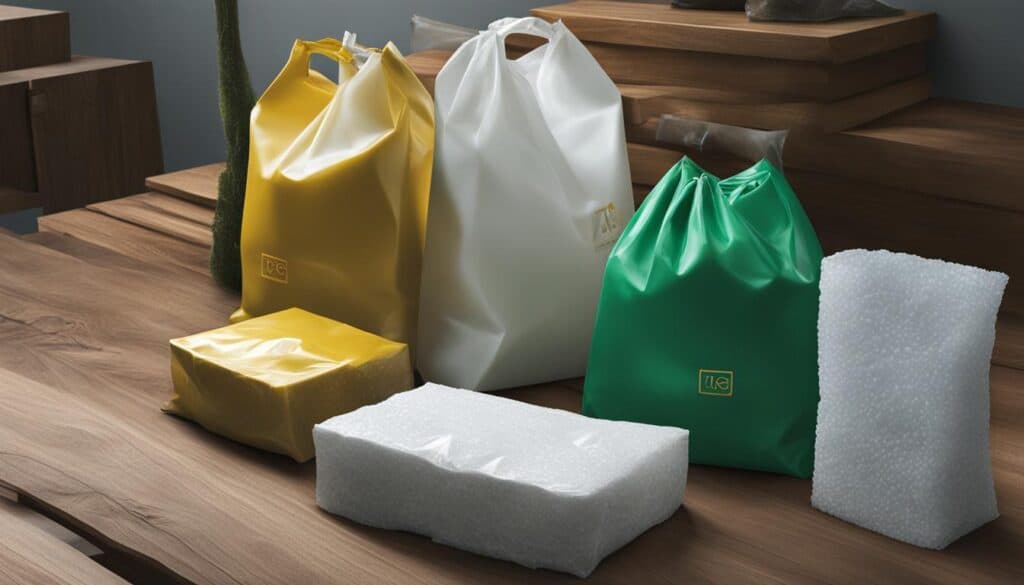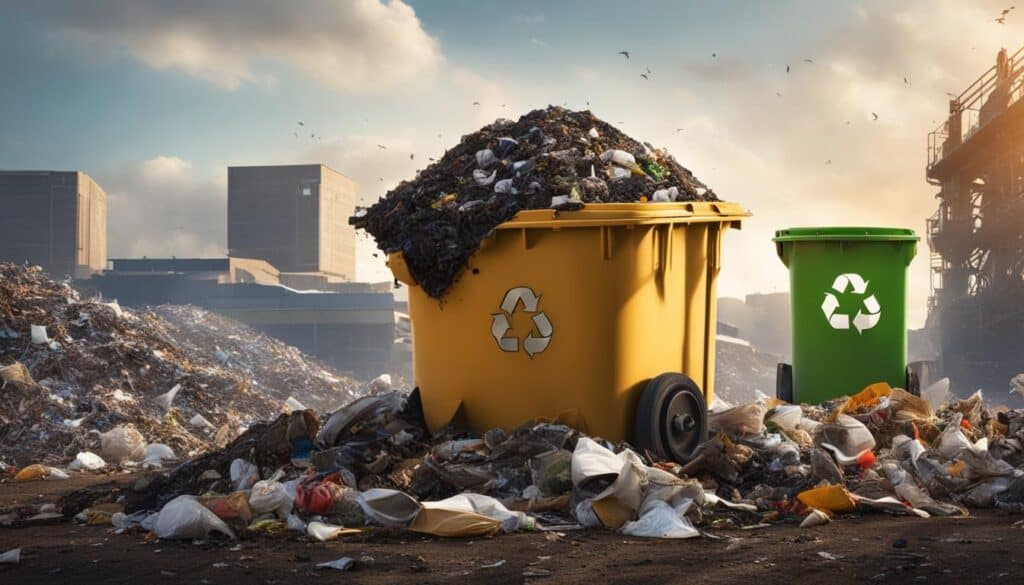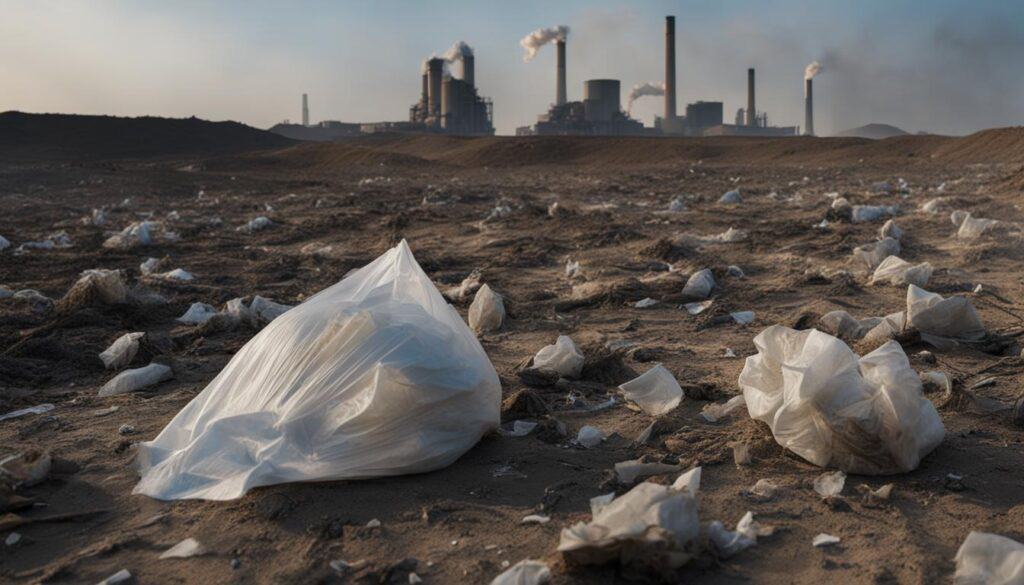Hello there, I hope this finds you in a green mood, because today we’re diving deep into the world of biodegradable products and sustainability.
Now, I’m sure you’ve noticed the surge in products dubbed as ‘biodegradable’, ‘compostable’, or ‘eco-friendly’ on the market. Faced with alarming reports on plastic pollution and landfill waste, many of us have embraced these green alternatives. But have you ever stopped to question just how ‘green’ these items really are?
Key Takeaways
- Understanding the difference between terms like ‘biodegradable’ and ‘compostable’ is essential to making wise purchasing decisions.
- Not all biodegradable products are as environmentally friendly as they seem. The overall environmental impact varies depending on production and disposal practices.
- Consumer awareness and understanding are key to combating common greenwashing tactics and supporting truly sustainable products.
- Reducing consumption and waste is still the most effective method for minimizing our individual environmental footprints.
- Education on green living practices can empower consumers to make a real difference in mitigating plastic pollution.
Understanding Biodegradability and Sustainability
In the age of heightened environmental awareness, buzzwords like “biodegradable” and “sustainable” have become increasingly popular. However, understanding their true meanings in today’s environmental context can be complex. Here, we delve deeper into these topics and explore how they intersect in the realm of green products.
Defining “Biodegradable” in Today’s Environmental Context
By the Oxford English Dictionary (OED) definition, “biodegradable” refers to a substance or object that is capable of being decomposed by bacteria or other living organisms. In simple terms, this means any material that can naturally break down and return to the environment. However, the crucial factor in this equation is the context in which degradation occurs.
For instance, many green products marketed as ‘biodegradable’ require specific industrial composting conditions to break down appropriately. These are often vastly different from natural environments or home composting setups, leading to diverse effects on their biodegradability. Thus, it’s essential to consider these variables when talking about biodegradable materials.
Measuring the Sustainability of Biodegradable Products
A product’s biodegradability only tells part of the environmental story. To grasp its overall impact on our planet, we must measure its sustainability across its entire lifecycle.
This measurement involves assessing the carbon dioxide emissions and environmental costs in each stage of the product’s life – from production and usage to disposal. It means a product, although biodegradable in nature, may still have a significant environmental footprint due to high energy consumption during manufacturing or inadequate decomposition methods.
The Role of Lifecycle Analysis in Environmental Impact
Lifecycle Analysis (LCA) becomes an essential tool in measuring the sustainability of biodegradable products. This systematic approach assesses the environmental impact associated with all stages of a product’s life. LCA can shed light on areas for improvement, ensuring the eco-friendliness of a product from the production phase to the end of its life.
Unfortunately, many biodegradable materials are often mislabelled as ‘degradable’, leading to confusion and misrepresentation of their true environmental impact. Degradable materials merely break down into smaller plastic pieces, contributing to plastic waste pollution, particularly in marine ecosystems. Thus, understanding the differences and implications of these terms is crucial for making truly eco-conscious decisions.
Are Biodegradable Products Really Sustainable: The Science Behind the Claim
In our continuous effort to embrace green options and lead a life that treads gently on the environment, we often look toward biodegradable products as an alternative to traditional plastics. These options seem to promise a level of eco-friendliness that puts our minds at ease and makes us believe we are contributing positively to our planet. However, we must always remember that not all that glitters is gold. Sometimes, it’s just a reflection of misleading sustainable claims.
Considerable sustainability research in the field of environmental science presents us with compelling evidence that biodegradable means sustainable is a leaps too quick. In his critical review of bioplastics and their effect on carbon footprint, renowned scientist Dr. DeArmitt points out that life cycle analysis and scientific evidence often make a powerful case for traditional plastics. This occurs especially in scenarios where biodegradability contributes to CO2 emissions or spawns microplastics, downgrading the plastic sustainability.
“Several Life Cycle Analysis (LCA) reports suggest that traditional plastics may be the greener option because they do not degrade to release carbon dioxide or leave behind microplastics,” Dr. DeArmitt affirms.
This statement brings us face to face with the contradiction that exists between environmental science findings and popular eco-conscious narratives. While the latter stem from a genuine desire to make a difference, they can also be amplified by certain media outlets that abandon due diligence and propagate sensational claims.
Take, for example, the observation that as many as 500 million straws are consumed daily in the United States. In the absence of verifiable data, this piece of information rapidly diffused into popular discourse, spurring an urgent demand for biodegradable alternatives. Yet, the science behind these ‘sustainable’ options might not stand robust scrutiny.
| Traditional Plastics | Biodegradable Alternatives |
|---|---|
| Lower carbon footprint provided there’s effective waste management system | Lower carbon footprint only if they undergo complete biodegradation |
| No CO2 emission unless incinerated | Releases CO2 on degradation |
| Can be recycled multiple times, reducing material need | Not all are recyclable or compostable, creating residual waste |
As we make daily choices – swayed often by popular claims – we must bear in mind that biodegradable does not always mean demonstrably sustainable. Let us rely on environmental science and its distilled wisdom to guide us, helping us reduce our carbon footprint consciously and effectively.
Misconceptions on the Environmental Benefits of Bioplastics

Bioplastics, often hailed as the panacea for our plastic pollution crisis, are increasingly making their way into our lives, in everything from disposable cutlery to plastic bag alternatives. But are they actually as eco-friendly as we think? The environmental benefits of bioplastics are more complex and less straightforward than they seem at the surface. This section delves into some of the common misconceptions around bioplastics, comparing them to conventional plastic and addressing the composting dilemma. Let’s dig a little deeper.
Comparing Bioplastics to Conventional Plastic
It’s easy to view bioplastics as a more environmentally friendly alternative to conventional plastic due to their biodegradable nature. They are, after all, made up of renewable biomass sources like plant starch, instead of fossil fuel-based polypropylene prevalent in traditional plastics. However, this view does not hold up under a full lifecycle assessment.
Studies have shown that metals and glass, and in some cases even paper, often have a higher environmental impact than conventional plastic. This is due to their resource-intensive manufacturing process and the higher carbon footprint associated with their transportation, due to their heavier weight.
The Composting Dilemma: Industrial vs. Home Composting
The touted environmental benefits of biodegradable materials often hit a roadblock when it comes to composting. The ideal decomposition of bioplastics requires specific conditions that are usually present in industrial composting facilities; conditions that are significantly different from the ones in home composting setups.
Industrial composting operations work at high temperatures and use specific bacteria to ensure full decomposition. These conditions can be hard to replicate in home composting situations, leading to incomplete degeneration of the bioplastics and resulting in residual microplastics. Such scenarios raise serious questions about the actual eco-friendliness of bioplastics and highlight the important role of accessibility and efficiency of industrial composting facilities.
In conclusion, while the use of bioplastics does show promise for reducing conventional plastic waste, it’s important to approach it with a critical eye and an understanding of its environmental context. If not correctly managed, the use of bioplastics can sometimes exacerbate environmental problems, rather than solving them. It’s essential for us to clearly understand the complex nature of biodegradable materials, the necessity of eco-friendly disposal methods like industrial composting, and the comprehensive lifecycle impacts of our material choices.
Biodegradable vs. Compostable: Clearing the Confusion
Many consumers interchangeably use the terms biodegradable and compostable when discussing eco-friendly materials. This not only leads to ambiguity but also hinders the effective application and disposal of these products. It’s high time we set the record straight and understand the true meaning of these terms and their applicability in real-world scenarios.
Defining Compostable Standards
Compostable products are those that break down under specific conditions and timescales defined by industrial composting standards. In the United States, a common certification to look for is the ASTM D6400, whereas in Europe, the EN13432 defines the compostability standards. The key here is that these certifications ensure the products not only break down completely but also leave no harmful residue in the process.
Compostable items are broken down into carbon dioxide, water, and biomass, without causing harm to the environment.
Industrial Composting vs. Biodegradability in Natural Environments
However, biodegradable products don’t necessarily meet these compostable standards. They simply break down into smaller pieces over time, under natural environmental conditions. The problem here is, these products can persist for years depending on the environment. Not all biodegradable materials break down completely or safely in natural environments. Consequently, biodegradability may result in remnants that contribute to pollution if not managed properly.
| Term | Certification | Decomposition Process | Potential Environmental Impact |
|---|---|---|---|
| Biodegradable | N/A | Breaks down into smaller pieces in natural environments | Potentially harmful as remnants can contribute to pollution |
| Compostable | ASTM D6400 (U.S.), EN13432 (Europe) | Completely breaks down into CO2, water, biomass in industrial composting facilities | Generally safe with no harmful residues left |
Understanding the definitions and implications of these two terms is crucial for making informed choices and debunking the misconceptions surrounding them.
The Role of Industrial Composting in the Biodegradable Equation
Our look at the biodegradable equation isn’t complete without discussing the paramount role of industrial composting. As sustainability champions, we must understand that the environmental benefits of biodegradables largely depend on access to proper waste treatment facilities. Indeed, industrial composting stands as a crucial component in limiting the carbon footprint of biodegradable products, even though such facilities remain notably scarce across the globe.
Limited Access to Composting Facilities: A Global Issue
Contrary to popular belief, green products don’t magically vanish after disposal. Instead, the decomposition of biodegradable and compostable materials requires specific settings found in global composting facilities. However, such facilities remain limited in number, and many regions struggle without proper waste management infrastructure. Thus, a significant chunk of our touted eco-friendly products fail to meet their potential due to insufficient composting system, significantly undercutting the touted environmental benefits-
Carbon Dioxide Emissions from Composting Organic Materials
A closer look at the organic decomposition process reveals surprising implications. Composting organic materials leads to the release of carbon dioxide, a potent greenhouse gas known for its role in climate change. If industrial composting is improperly managed or inaccessible for many, the result can be a spike in CO2 emissions that goes unchecked, once more challenging the idealistic notion of biodegradable as an indisputably earth-friendly choice.
| Ideal Composting Conditions | Potential Emissions | Environmental Impact |
|---|---|---|
| High Temperature | Reduced | Minimized Negative Impact |
| Low Temperature | Increased | Higher Carbon Footprint |
| Adequate Oxygen | Maintains Balance | Keeps Emissions under Control |
| Insufficient Oxygen | Spikes | Inflates Carbon Footprint |
From this exploration of industrial composting and environmental sustainability, it’s clear that mere utilization of biodegradable materials isn’t a silver bullet for waste management. Instead, the seemingly simple equation gets complicated by global accessibility to composting facilities and the inevitable CO2 emissions during decomposition process. Thus, while taking the leap towards a greener lifestyle, we must navigate these complexities conscientiously to genuinely contribute to fostering a more sustainable planet.
Challenges with Recycling Biodegradable Materials

In the pursuit of environmental sustainability, it is increasingly recognized that the recycling of biodegradable materials is accompanied by a host of recycling challenges. While recycling has been touted as a solution for managing increasing waste, the specific requirements of biodegradable materials highlight a complex reality.
Biodegradable materials cannot be processed alongside traditional recyclables due to their unique decomposition behaviors. These substances often require separate treatment methods and recycling streams, leading to increased complexity in waste management systems. Despite the eco-friendly intentions, the lack of availability of these designated recycling streams often results in a significant portion of biodegradable products ending up in landfills.
Worse still, any benefits of these green products can be negated with mismanagement of waste and insufficient recycling infrastructure. Miscommunication and lack of education lead to incorrect disposal methods, exacerbating the problem and increasing the negative environmental impact. Composting, which is one effective method of recycling biodegradable materials, is not always possible due to lack of facilities and awareness. These challenges underline the need for better infrastructure and widespread education on eco-friendly practices.
The goal of sustainability is often countered by the reality of existing infrastructure and systems. We need to rethink and redesign these systems to fully leverage the potential of biodegradable materials.
Efforts to recycle bioplastics, specifically, often face their own set of challenges. Bioplastics are frequently omitted in recycling efforts due to controversies around their material composition and recovery process. If not properly sorted, bioplastics can contaminate recycling streams, reducing the quality and resale value of recycled plastic. Ultimately, the challenges in recycling biodegradable materials emphasize the need for sustainable recycling practices and improved systems to truly advance towards environmental sustainability.
| Challenges | Implications | Solutions |
|---|---|---|
| Different decomposition behaviors | Requires separate recycling stream | Develop dedicated recycling processes for biodegradable materials |
| Mismanagement of waste | Increased environmental impact | Invest in education and awareness campaigns on waste management |
| Lack of composting facilities | Biodegradables end up in landfill | Build more industrial composting facilities |
| Confusion over bioplastics | Contamination of recycling stream | Create clear labeling and sorting guidelines |
While the challenges are significant, they also provide us with an opportunity. Recognizing these obstacles can inspire change and innovation, helping us to transition towards more sustainable recycling practices that truly benefit our planet.
The Truth About Oxo-degradable and Eco-Friendly Claims

While sustainability movements are gaining traction across the globe, it’s essential to scrutinize the real impact of touted eco-friendly alternatives, particularly when it comes to plastics. Certain types of plastics, namely, oxo-degradable plastics, and the underlying perceptions that propel their market underscore the necessity for informed consumership.
Understanding Oxo-Degradable Plastics
Oxo-degradable plastics are increasingly used for packaging and other disposable materials due to the perception that they are an eco-friendly alternative to traditional plastic. They are made to degrade faster through the integration of specific polymer additives. However, this degradation often results in fragmentation into tiny particles rather than complete biodegradation. These fragments can contribute significantly to microplastic pollution, posing a serious threat to both terrestrial and aquatic ecosystems.
Misleading Marketing Practices in Biodegradable Products
These plastics often bear eco-friendly claims, posturing as a solution for the massive environmental impact of plastic waste. However, due to their inability to fully biodegrade, such claims can be categorized as misleading marketing, also known as greenwashing. Such deceptive practices complicate the scenario for consumers who are striving to make environmentally responsible choices.
| Type of Plastic | Claimed Attributes | Actual Behaviour | Environmental Impact |
|---|---|---|---|
| Oxo-Degradable Plastics | Eco-friendly, Biodegradable | Fragment into microplastics | Contributes to microplastic pollution |
| Biodegradable Plastics | Completely return to nature | Depend on industrial composting conditions for complete decomposition | Can end up as waste in landfills or contribute to CO2 emissions if not composted properly. |
| Photodegradable Plastics | Break down under sunlight | Fragment into microplastics in absence of high-intensity UV light | Contributes to microplastic pollution |
Sorting out fact from marketing hyperbole in such cases is crucial to truly aligning consumption habits with real sustainability. It serves as a reminder to be diligent about verifying sustainability claims and wary of products that only appear to be the greener choice based purely on face-value.
Examining the Long Term Effects of Biodegradables on the Planet

We’ve been advocating the adoption of biodegradable products as a viable solution to the environmental problems that we currently grapple with. But, biodegradables aren’t exactly as innocent as they seem. The truth is that their impact on our planet, particularly on our soil and marine ecosystems might be profound.
Assessing the Impact on Soil and Marine Environments
Using biodegradable products can indeed reduce our reliance on plastics, but the improper handling of these products can create new problems. Biodegradable waste often ends up in landfills where it decomposes over extended periods, consequently releasing greenhouse gases like methane, which is more potent than carbon dioxide. This can intensify the greenhouse effect and exacerbate global warming, thereby having a direct and severe impact on the planet.
Furthermore, in soil and marine environments, biodegradable waste can disrupt the balance of ecosystems. As it slowly decomposes, it may leach harmful substances into the soil or marine habitats. This may harm the growth of plants in the soil and affect marine life forms.
Addressing the Microplastic Problem
Another troubling aspect associated with biodegradable products is the well-documented ‘microplastic problem.’ If biodegradables degrade incompletely, they might crumble into microplastics, which are minute pieces of plastic debris less than 5mm in length. The ubiquity of microplastics in marine environments is particularly worrisome, as these particles get ingested by marine organisms, thereby entering the food chain and presenting potential risks to human health.
Even if our current sustainability efforts steer towards adopting biodegradable or ‘green products’, we need to be aware of the potential consequences and the planetary impact of their usage. In essence, although these products may seem more eco-friendly than traditional plastics, they still have an environmental footprint that warrants thorough examination.
Taking Stock of the Problem: A Snapshot
| Impact | Outcome |
|---|---|
| Soil Environment | Potential leaching of harmful substances affecting plant growth. |
| Marine Environment | Possible microplastic buildup affecting marine life. |
| Global Warming | Methane emission from degradation in landfills contributing to the greenhouse effect. |
| Human Health | Ingestion of microplastics through the food chain. |
Given this predicament, it’s glaringly obvious that we need to adopt more comprehensive measures to manage biodegradable waste. Above all, we must all strive to minimize waste generation in the first place. Remember, the most eco-friendly product is the one you didn’t buy.
Best Practices for Consumers Seeking Biodegradable Options
As environmentally-conscious citizens, it’s paramount to promote sustainability and make green choices. This involves identifying truly sustainable biodegradable products and reducing our overall consumption. Here are two vital strategies to enhance our eco-friendly shopping habits:
How to Identify Truly Sustainable Biodegradable Products
Unfortunately, not all biodegradable products are as eco-friendly as they claim to be. Many are cloaked in deceptive packaging and marketing, giving the illusion of sustainability without truly meeting the criteria. Savvy consumers can cut through this greenwashing by looking for reputable certifications such as B-Corp, which signifies a company’s commitment to environmental, social, and governance standards. Further, scrutinizing ingredient lists and sourcing information can provide insights into a product’s sustainability in the value chain.
Guidance on Reducing Overall Consumption for Environmental Gains
Reducing consumption remains the most effective strategy for diminishing our ecological footprints. By focusing on buying less but buying better, we can make a substantial impact. Conscious consumerism involves understanding the life cycle and the true cost of the products we buy. This might involve choosing quality over quantity, opting for products with efficient lifecycle assessments, or simply repairing and reusing rather than discarding and replacing.
For a quick reference on the quest to make sustainable choices, here’s a table summarizing key tips:
| Best Practices | Guidelines | Benefits |
|---|---|---|
| Identify Authentic Biodegradable Products | Look for B-Corp certification and scrutinize ingredient lists. | You favor truly sustainable products and companies committed to responsible practices. |
| Sustain Conscious Consumerism | Focus on quality over quantity and be mindful of the life cycle and true cost of products. | You decrease demand for unsustainable, single-use items, leading to a lighter ecological footprint. |
We are the guardians of our Earth, and every step we take towards sustainability matters. Though the journey is long, the environmental gains will be worth it.
Conclusion on Are Biodegradable Products Really Sustainable?
In our deep dive into the subject of biodegradable sustainability, we’ve seen an evident paradox. While biodegradable products may hold the promise of potential environmental benefits, these advantages are entwined in the complex realities of production, disposal, and the pervasive problem of greenwashing.
It’s clear that we can’t simply accept eco-friendly claims at face value. Critical analysis and due diligence are essential for understanding the full environmental impact of these products. As consumers, it’s our responsibility to explore the ecological footprint we create with our purchasing decisions and to seek out truly eco-friendly alternatives.
The key to sustainable living is not about replacing one form of waste with another, but about reducing our overall consumption. This involves finding verifiable green products and being aware of the amount of plastic waste we generate. By making informed decisions and lobbying for transparent practices from companies, we can play a role in preserving our natural resources – benefiting not just ourselves, but future generations as well.
In conclusion, achieving true sustainability is not an easy or straightforward task. But as we continue to learn and adapt, we can navigate the complexities and make a real difference in preserving the planet for those who come after us.
FAQ on Bio-Based and Biodegradable Plastics
What does “biodegradable” truly mean in the context of environmental sustainability?
“Biodegradable” means that a product can break down into natural elements, carbon dioxide, and biomass. However, the context in which it biodegrades is essential. Industrial composting settings are very different from natural environments, and degradation in the wrong setting can contribute to pollution.
Are all biodegradable products sustainable by default?
Biodegradable products are not categorically more sustainable than traditional plastics. It requires a comprehensive lifecycle analysis to account for the environmental costs from production to disposal. Misunderstandings of the term “biodegradable” have led to misconceptions about its actual environmental impact.
How does biodegradable plastic compare to conventional plastic in terms of environmental impact?
Bioplastics are often marketed as an eco-friendly alternative to conventional plastics. However, compared to other materials, conventional plastics have been observed in life cycle assessments to have a lower environmental impact. The benefits of biodegradable materials are contingent upon the right composting conditions, which often require industrial facilities.
What’s the difference between biodegradable and compostable products?
There’s confusion between “biodegradable” and “compostable” products. The latter undergoes a regulated process to break down in industrial composting facilities. Standards ensure that certified products can be composted under specific conditions, unlike biodegradable products, whose breakdown doesn’t necessarily involve complete assimilation especially under inadequate composting settings.
What role does industrial composting play in the sustainability of biodegradable products?
Industrial composting is crucial to the potential sustainability of biodegradable products, subject to the actual availability of such facilities globally. It’s necessary to mitigate increased CO2 emissions and avoid incomplete degradation of compostable materials, which could elevate the levels of harmful greenhouse gases.
Are there challenges associated with recycling biodegradable materials?
Yes, biodegradable materials pose recycling challenges as they cannot be processed alongside traditional recyclables due to their different decomposition behaviors. They require specific treatment and recycling streams which aren’t always available, causing a significant portion of them to end up in landfills.
What are oxo-degradable plastics and how do they affect the environment?
Oxo-degradable plastics are designed to fragment into smaller pieces through the addition of additives, but they do not fully biodegrade in landfills or composting settings. Misleading marketing can create a misconception that they’re biodegradable, contributing to microplastic pollution and more environmental problems.
What are the long term effects of biodegradable products on the planet?
The long-term effects of biodegradable products raise concerns in soil and marine environments where incomplete degradation can lead to the accumulation of microplastics. These small particles pose l significant risks to wildlife, ecosystems, and could find their way into the human food chain. Moreover, the degradation of biodegradables can contribute to greenhouse gas emissions, further complicating their sustainability evaluations.
How can consumers make sustainable choices when selecting biodegradable products?
Consumers can identify truly sustainable biodegradable products by looking for reputable certifications, scrutinizing ingredient lists, and reducing their overall consumption. Conscious consumerism, where the life cycle and true cost of products are considered, can lead to reduced demand for single-use items and a lighter ecological footprint.
Source Links
- https://www.knowyourh2o.com/water-blog/plastics-and-the-environment-debunking-myths-responsible-practices
- https://www.technicianonline.com/culture/debunking-sustainability-myths-misconceptions/article_bca42a5a-d352-11ed-a4ed-73bf0baab17e.html
- https://hellocharlie.com.au/blogs/sustainable-living/dont-be-fooled-we-bust-9-myths-about-so-called-eco-products





Leave a Reply